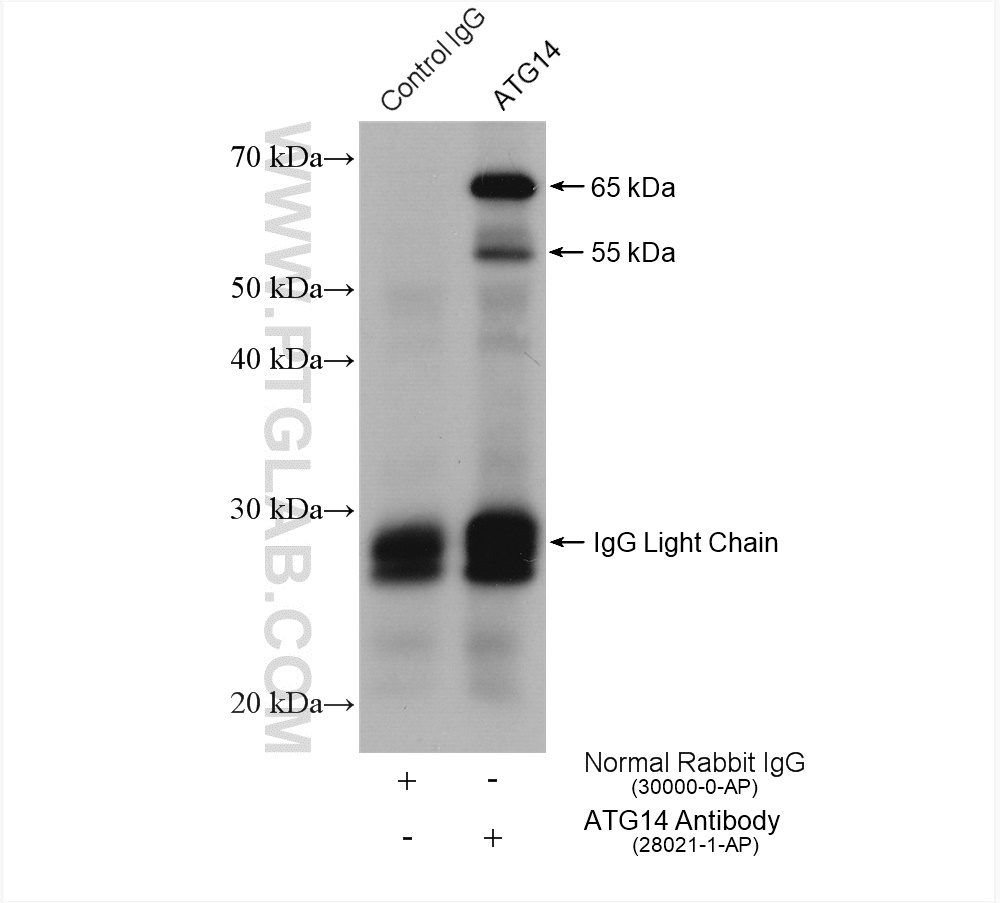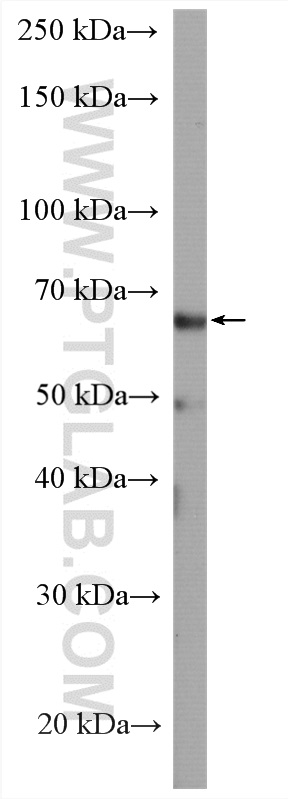验证数据展示
经过测试的应用
| Positive WB detected in | mouse brain tissue, A549 cells, rat brain tissue |
| Positive IP detected in | rat brain tissue |
| Positive IHC detected in | human liver cancer tissue Note: suggested antigen retrieval with TE buffer pH 9.0; (*) Alternatively, antigen retrieval may be performed with citrate buffer pH 6.0 |
推荐稀释比
| 应用 | 推荐稀释比 |
|---|---|
| Western Blot (WB) | WB : 1:500-1:2000 |
| Immunoprecipitation (IP) | IP : 0.5-4.0 ug for 1.0-3.0 mg of total protein lysate |
| Immunohistochemistry (IHC) | IHC : 1:200-1:800 |
| It is recommended that this reagent should be titrated in each testing system to obtain optimal results. | |
| Sample-dependent, Check data in validation data gallery. | |
产品信息
28021-1-AP targets ATG14/Barkor in WB, IHC, IP, ELISA applications and shows reactivity with Human, Mouse, Rat samples.
| 经测试应用 | WB, IP, IHC, ELISA Application Description |
| 文献引用应用 | WB, IHC, IP |
| 经测试反应性 | Human, Mouse, Rat |
| 文献引用反应性 | human, mouse |
| 免疫原 | ATG14/Barkor fusion protein Ag27671 种属同源性预测 |
| 宿主/亚型 | Rabbit / IgG |
| 抗体类别 | Polyclonal |
| 产品类型 | Antibody |
| 全称 | KIAA0831 |
| 别名 | ATG14, Atg14L, Barkor, KIAA0831 |
| 计算分子量 | 55 kDa |
| 观测分子量 | 55 and 65 kDa |
| GenBank蛋白编号 | NM_014924 |
| 基因名称 | ATG14 |
| Gene ID (NCBI) | 22863 |
| RRID | AB_2881038 |
| 偶联类型 | Unconjugated |
| 形式 | Liquid |
| 纯化方式 | Antigen affinity purification |
| UNIPROT ID | Q6ZNE5 |
| 储存缓冲液 | PBS with 0.02% sodium azide and 50% glycerol pH 7.3. |
| 储存条件 | Store at -20°C. Stable for one year after shipment. Aliquoting is unnecessary for -20oC storage. |
背景介绍
ATG14 plays a critical role in autophagy which is required for both basal and inducible autophagy. It has been reported that the loss of ATG14 completely blocks autophagic fusion with lysosomes. ATG14 is associated with the location of PI3-kinase complex PI3KC3-C1 and the formation of autophagosome. Besides, BECN2 can form the BECN2:ATG14 heterodimer with ATG14. 28021-1-AP antibody recognizes the 55 kDa protein and the phosphorylated 65 kDa protein in SDS-PAGE. (PMID: 28218432, 24597603, 30894050)
实验方案
| Product Specific Protocols | |
|---|---|
| WB protocol for ATG14/Barkor antibody 28021-1-AP | Download protocol |
| IHC protocol for ATG14/Barkor antibody 28021-1-AP | Download protocol |
| IP protocol for ATG14/Barkor antibody 28021-1-AP | Download protocol |
| Standard Protocols | |
|---|---|
| Click here to view our Standard Protocols |
发表文章
| Species | Application | Title |
|---|---|---|
Autophagy The mammalian actin elongation factor ENAH/MENA contributes to autophagosome formation via its actin regulatory function | ||
Cancer Lett Targeting PP2A with lomitapide suppresses colorectal tumorigenesis through the activation of AMPK/Beclin1-mediated autophagy. | ||
Ecotoxicol Environ Saf Weakened interaction of ATG14 and the SNARE complex blocks autophagosome-lysosome fusion contributes to fluoride-induced developmental neurotoxicity. | ||
Cells Cytosolic HMGB1 Mediates LPS-Induced Autophagy in Microglia by Interacting with NOD2 and Suppresses Its Proinflammatory Function | ||
Life (Basel) MiR-371a-5p Positively Associates with Hepatocellular Carcinoma Malignancy but Sensitizes Cancer Cells to Oxaliplatin by Suppressing BECN1-Dependent Autophagy | ||
FASEB J Melatonin ameliorates cerebral ischemia-reperfusion injury in diabetic mice by enhancing autophagy via the SIRT1-BMAL1 pathway |




